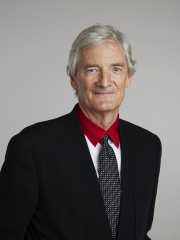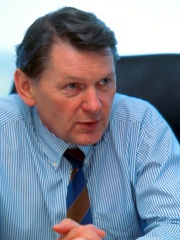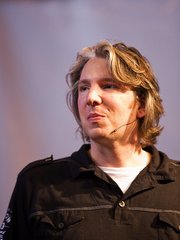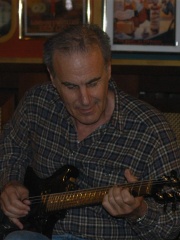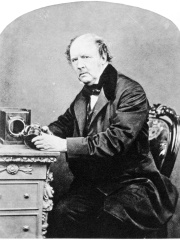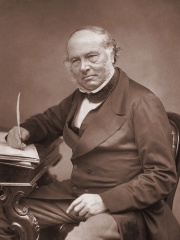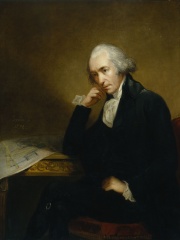

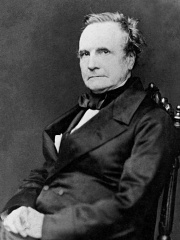
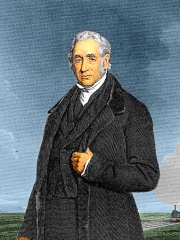

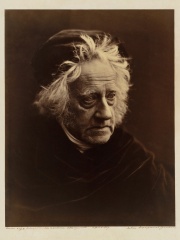
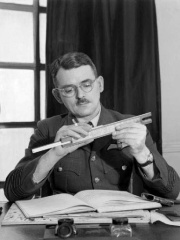
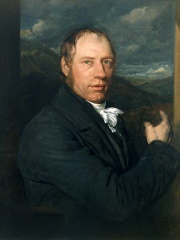
The Most Famous
INVENTORS from United Kingdom
This page contains a list of the greatest British Inventors. The pantheon dataset contains 426 Inventors, 69 of which were born in United Kingdom. This makes United Kingdom the birth place of the 2nd most number of Inventors.
Top 10
The following people are considered by Pantheon to be the top 10 most legendary British Inventors of all time. This list of famous British Inventors is sorted by HPI (Historical Popularity Index), a metric that aggregates information on a biography's online popularity. Visit the rankings page to view the entire list of British Inventors.

1. James Watt (1736 - 1819)
With an HPI of 88.47, James Watt is the most famous British Inventor. His biography has been translated into 143 different languages on wikipedia.
James Watt (; 30 January 1736 (19 January 1736 OS) – 25 August 1819) was a Scottish inventor, engineer and chemist who improved on Thomas Newcomen's 1712 Newcomen steam engine with his Watt steam engine in 1776, which was fundamental to the changes brought by the Industrial Revolution in both his native Great Britain and the rest of the world. While working as an instrument maker at the University of Glasgow, Watt became interested in the technology of steam engines. At the time engineers such as John Smeaton were aware of the inefficiencies of Newcomen's engine and aimed to improve it. Watt's insight was to realise that contemporary engine designs wasted a great deal of energy by repeatedly cooling and reheating the cylinder. Watt introduced a design enhancement, the separate condenser, which avoided this waste of energy and radically improved the power, efficiency, and cost-effectiveness of steam engines. Eventually, he adapted his engine to produce rotary motion, greatly broadening its use beyond pumping water. Watt attempted to commercialise his invention, but experienced great financial difficulties until he entered a partnership with Matthew Boulton in 1775. The new firm of Boulton and Watt was eventually highly successful and Watt became a wealthy man. In his retirement, Watt continued to develop new inventions though none was as significant as his steam engine work. As Watt developed the concept of horsepower, the SI unit of power, the watt, was named after him.

2. Alexander Graham Bell (1847 - 1922)
With an HPI of 85.31, Alexander Graham Bell is the 2nd most famous British Inventor. His biography has been translated into 128 different languages.
Alexander Graham Bell ( ; born Alexander Bell; March 3, 1847 – August 2, 1922) was a Scottish-born Canadian-American inventor, scientist, and engineer who is credited with patenting the first practical telephone. He also co-founded the American Telephone and Telegraph Company (AT&T) in 1885. Bell's father, grandfather, and brother had all been associated with work on elocution and speech, and both his mother and wife were deaf, profoundly influencing Bell's life's work. His research on hearing and speech further led him to experiment with hearing devices, which eventually culminated in his being awarded the first U.S. patent for the telephone, on March 7, 1876. Bell considered his invention an intrusion on his real work as a scientist and refused to have a telephone in his study. Many other inventions marked Bell's later life, including ground-breaking work in optical telecommunications, hydrofoils, and aeronautics. Bell also had a strong influence on the National Geographic Society and its magazine while serving as its second president from 1898 to 1903. Beyond his work in engineering, Bell had a deep interest in the emerging science of heredity. His work in this area has been called "the soundest, and most useful study of human heredity proposed in nineteenth-century America ... Bell's most notable contribution to basic science, as distinct from invention."

3. Charles Babbage (1791 - 1871)
With an HPI of 81.59, Charles Babbage is the 3rd most famous British Inventor. His biography has been translated into 98 different languages.
Charles Babbage (; 26 December 1791 – 18 October 1871) was an English polymath. A mathematician, philosopher, inventor and mechanical engineer, Babbage originated the concept of a digital programmable computer. Babbage is considered by some to merit the title of "father of the computer". He is credited with inventing the first mechanical computer, the difference engine, that eventually led to more complex electronic designs, though all the essential ideas of modern computers are to be found in his analytical engine, programmed using a principle openly borrowed from the Jacquard loom. As part of his computer work, he also designed the first computer printers. He had a broad range of interests in addition to his work on computers, covered in his 1832 book Economy of Manufactures and Machinery. He was an important figure in the social scene in London, and is credited with importing the "scientific soirée" from France with his well-attended Saturday evening soirées. His varied work in other fields has led him to be described as "pre-eminent" among the many polymaths of his century. Babbage, who died before the complete successful engineering of many of his designs, including his Difference Engine and Analytical Engine, remained a prominent figure in the ideating of computing. Parts of his incomplete mechanisms are on display in the Science Museum in London. In 1991, a functioning difference engine was constructed from the original plans. Built to tolerances achievable in the 19th century, the success of the finished engine indicated that Babbage's machine would have worked.

4. George Stephenson (1781 - 1848)
With an HPI of 77.03, George Stephenson is the 4th most famous British Inventor. His biography has been translated into 70 different languages.
George Stephenson (9 June 1781 – 12 August 1848) was a British civil engineer and mechanical engineer. Renowned as the "Father of Railways", Stephenson was considered by the Victorians as a great example of diligent application and thirst for improvement. His chosen rail gauge, sometimes called "Stephenson gauge", was the basis for the 4-foot-8+1⁄2-inch (1.435 m) standard gauge used by most of the world's railways. Pioneered by Stephenson, rail transport was one of the most important technological inventions of the 19th century and a key component of the Industrial Revolution. Built by George and his son Robert's company Robert Stephenson and Company, the Locomotion No. 1 was the first steam locomotive to carry passengers on a public rail line, the Stockton and Darlington Railway in 1825. George also built the first public inter-city railway line in the world to use locomotives, the Liverpool and Manchester Railway, which opened in 1830. Following this, according to Encyclopedia Britannica, "Stephenson continued as the chief guide of the revolutionary transportation medium, solving problems of roadway construction, bridge design, and locomotive and rolling-stock manufacture. He built many other railways in the Midlands, and he acted as consultant on many railroad projects at home and abroad."
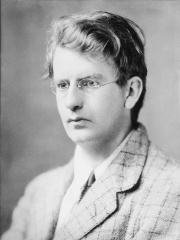
5. John Logie Baird (1888 - 1946)
With an HPI of 75.44, John Logie Baird is the 5th most famous British Inventor. His biography has been translated into 76 different languages.
John Logie Baird (; 13 August 1888 – 14 June 1946) was a Scottish inventor, electrical engineer, and innovator who demonstrated the world's first mechanical television system on 26 January 1926. He went on to invent the first publicly demonstrated colour television system and the first viable purely electronic colour television picture tube. In 1928, the Baird Television Development Company achieved the first transatlantic television transmission. Baird's early technological successes and his role in the practical introduction of broadcast television for home entertainment have earned him a prominent place in television's history. In 2006, Baird was named as one of the 10 greatest Scottish scientists in history, having been listed in the National Library of Scotland's 'Scottish Science Hall of Fame'. In 2015, he was inducted into the Scottish Engineering Hall of Fame. In 2017, IEEE unveiled a bronze street plaque at 22 Frith Street (Bar Italia), London, dedicated to Baird and the invention of television. In 2021, the Royal Mint unveiled a John Logie Baird 50p coin commemorating the 75th anniversary of his death.

6. Thomas Newcomen (1663 - 1729)
With an HPI of 75.31, Thomas Newcomen is the 6th most famous British Inventor. His biography has been translated into 55 different languages.
Thomas Newcomen (; February 1664 – 5 August 1729) was an English inventor, creator of the atmospheric engine in 1712, Baptist preacher by calling and ironmonger by trade. He was born in Dartmouth, in Devon, England, to a merchant family and baptized at St. Saviour's Church on 28 February 1664. In those days, flooding in coal and tin mines was a major problem. Newcomen was soon engaged in trying to improve ways to pump out the water from such mines. His ironmonger's business specialised in designing, manufacturing and selling tools for the mining industry.

7. John Herschel (1792 - 1871)
With an HPI of 74.80, John Herschel is the 7th most famous British Inventor. His biography has been translated into 75 different languages.
Sir John Frederick William Herschel, 1st Baronet (; 7 March 1792 – 11 May 1871) was an English polymath active as a mathematician, astronomer, chemist, inventor and experimental photographer who invented the blueprint and did botanical work. Herschel originated the use of the Julian day system in astronomy. He named seven moons of Saturn and four moons of Uranus – the seventh planet, discovered by his father Sir William Herschel. He made many contributions to the science of photography, and investigated colour blindness and the chemical power of ultraviolet rays. His Preliminary Discourse (1831), which advocated an inductive approach to scientific experiment and theory-building, was an important contribution to the philosophy of science.

8. Frank Whittle (1907 - 1996)
With an HPI of 74.32, Frank Whittle is the 8th most famous British Inventor. His biography has been translated into 41 different languages.
Air Commodore Sir Frank Whittle, (1 June 1907 – 8 August 1996) was an English engineer, inventor and Royal Air Force (RAF) air officer. He is credited with co-creating the turbojet engine. A patent was submitted by Maxime Guillaume in 1921 for a similar invention which was technically unfeasible at the time. Whittle's jet engines were developed some years earlier than those of Germany's Hans von Ohain, who designed the first-to-fly turbojet engine as well as Austria’s Anselm Franz. Whittle demonstrated an aptitude for engineering and an interest in flying from an early age. At first he was turned down by the RAF but, determined to join the force, he overcame his physical limitations and was accepted and sent to No. 2 School of Technical Training to join No 1 Squadron of Cranwell Aircraft Apprentices. He was taught the theory of aircraft engines and gained practical experience in the engineering workshops. His academic and practical abilities as an Aircraft Apprentice earned him a place on the officer training course at Cranwell. He excelled in his studies and became an accomplished pilot. While writing his thesis he formulated the fundamental concepts that led to the creation of the turbojet engine, taking out a patent on his design in 1930. His performance on an officers' engineering course earned him a place on a further course at Peterhouse, Cambridge, where he graduated with a First. Without Air Ministry support, he and two retired RAF servicemen formed Power Jets Ltd to build his engine with assistance from the firm of British Thomson-Houston. Despite limited funding, a prototype was created, which first ran in 1937. Official interest was forthcoming following this success, with contracts being placed to develop further engines, but the continuing stress seriously affected Whittle's health, eventually resulting in a nervous breakdown in 1940. In 1944 when Power Jets was nationalised he again suffered a nervous breakdown, and resigned from the board in 1946. In 1948, Whittle retired from the RAF and received a knighthood. He joined BOAC as a technical advisor before working as an engineering specialist with Shell, followed by a position with Bristol Aero Engines. After emigrating to the U.S. in 1976 he accepted the position of NAVAIR Research Professor at the United States Naval Academy from 1977 to 1979. In August 1996, Whittle died of lung cancer at his home in Columbia, Maryland. In 2002, Whittle was ranked number 42 in the BBC poll of the 100 Greatest Britons.

9. Richard Trevithick (1771 - 1833)
With an HPI of 72.40, Richard Trevithick is the 9th most famous British Inventor. His biography has been translated into 54 different languages.
Richard Trevithick (13 April 1771 – 22 April 1833) was a British inventor and mining engineer. The son of a mining captain, and born in the mining heartland of Cornwall, Trevithick was immersed in mining and engineering from an early age. He was an early pioneer of steam-powered road and rail transport, and his most significant contributions were the development of the first high-pressure steam engine and the first working railway steam locomotive. The world's first locomotive-hauled railway journey took place on 21 February 1804, when Trevithick's unnamed steam locomotive hauled a train along the tramway of the Penydarren Ironworks, in Merthyr Tydfil, Wales. Turning his interests abroad Trevithick also worked as a mining consultant in Peru and later explored parts of Costa Rica. Throughout his professional career he went through many ups and downs and at one point faced financial ruin, also suffering from the strong rivalry of many mining and steam engineers of the day. During the prime of his career he was a well-known and highly respected figure in mining and engineering, but near the end of his life he fell out of the public eye. Trevithick was extremely strong and was a champion Cornish wrestler.
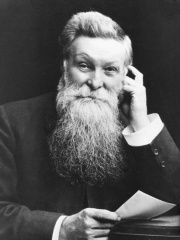
10. John Boyd Dunlop (1840 - 1921)
With an HPI of 71.68, John Boyd Dunlop is the 10th most famous British Inventor. His biography has been translated into 50 different languages.
John Boyd Dunlop (5 February 1840 – 23 October 1921) was a Scottish inventor and veterinary surgeon who spent most of his career in Ireland. Familiar with making rubber devices, he invented the practical pneumatic tyres for his child's tricycle and developed them for use in cycle racing. He sold his rights to the pneumatic tyres to a company he formed with the president of the Irish Cyclists' Association, Harvey du Cros, for a small cash sum and a small shareholding in their pneumatic tyre business. Dunlop withdrew in 1896. The company that bore his name, Dunlop Pneumatic Tyre Company, was not incorporated until later and, despite its name, was Du Cros's creation.
People
Pantheon has 69 people classified as British inventors born between 1625 and 1971. Of these 69, 4 (5.80%) of them are still alive today. The most famous living British inventors include James Dyson, John Barnard, and Edd China. The most famous deceased British inventors include James Watt, Alexander Graham Bell, and Charles Babbage. As of April 2024, 1 new British inventors have been added to Pantheon including Edd China.
Living British Inventors
Go to all RankingsJames Dyson
1947 - Present
HPI: 61.68
John Barnard
1946 - Present
HPI: 58.68
Edd China
1971 - Present
HPI: 52.45
Roger C. Field
1945 - Present
HPI: 51.29
Deceased British Inventors
Go to all RankingsJames Watt
1736 - 1819
HPI: 88.47
Alexander Graham Bell
1847 - 1922
HPI: 85.31
Charles Babbage
1791 - 1871
HPI: 81.59
George Stephenson
1781 - 1848
HPI: 77.03
John Logie Baird
1888 - 1946
HPI: 75.44
Thomas Newcomen
1663 - 1729
HPI: 75.31
John Herschel
1792 - 1871
HPI: 74.80
Frank Whittle
1907 - 1996
HPI: 74.32
Richard Trevithick
1771 - 1833
HPI: 72.40
John Boyd Dunlop
1840 - 1921
HPI: 71.68
Henry Fox Talbot
1800 - 1877
HPI: 70.63
Rowland Hill
1795 - 1879
HPI: 69.62
Newly Added British Inventors (2025)
Go to all RankingsOverlapping Lives
Which Inventors were alive at the same time? This visualization shows the lifespans of the 25 most globally memorable Inventors since 1700.

